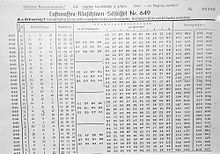Clash (cryptology)
Clash ( / klæʃ / ; plural: clashes ; German collision, clatter, contradiction ) is a special technical term in cryptanalysis . It was used by British code breakers in Bletchley Park ( BP ), England, in connection with the Enigma key rotor machine and describes the repeated occurrence of the same Enigma roller in the same position in the roller set on two consecutive days within a month.
Clash must not be confused with crash (a letter collision in plain and ciphertext ).
background

During the Second World War , the Wehrmacht used the Enigma to encrypt its secret radio messages . The critical element here is the key , which enables the authorized recipient of the message to decrypt the ciphertext generated by the sender and sent to him and thus receive the original plain text . There were also key boards ( top secret at the time) (picture) that listed the daily changing key for a full month in a table and were distributed in advance to the sender and recipient. For the Enigma I used by the army and air force , five different rollers were available, which were numbered with Roman numerals (I, II, III, IV and V). The user selected three of the five rollers according to the specifications of the key table and inserted them according to the arrangement prescribed in the daily key under the heading "Roller position". There were 5 · 4 · 3 = 60 options for setting up the key for the roller position , as can be seen in the following table (for the sake of clarity , indicated here with Arabic numerals ).
123 124 125 132 134 135 142 143 145 152 153 154 213 214 215 231 234 235 241 243 245 251 253 254 312 314 315 321 324 325 341 342 345 351 352 354 412 413 415 421 423 425 431 432 435 451 452 453 512 513 514 521 523 524 531 532 534 541 542 543
The German authorities, such as Group III "Key Supply" of the OKW's encryption department , have come up with special rules for setting up the key tables in order to allegedly reduce the risk of key guessing. This included the fact that a roller was not allowed to be in the same place in the roller set on two consecutive days of the month, in the jargon of the British codebreakers this was an avoidance of clashes .
If, for example, "I IV III" was stipulated as the roller arrangement on a certain day, meaning that roller I was to be inserted on the left, roller IV in the middle and roller III on the right, then the German office which generated the secret keyboards, deliberately avoided that the next day the roller I came up again on the left, the roller IV again in the middle or the roller III again on the right. Due to this self-restriction, some roller positions were no longer available or were deliberately avoided on the following day. The corresponding cases are crossed out in the following table for illustration.
123124125132134135142143145152153154213214 215 231 234 235241243245251253254 312 314 315 321 324 325341342345351 352 354 412413415 421423425 431 432 435 451 452453512513514 521523524 531 532 534541542543
As a result, instead of the original 60 roller layers, only 32 are available, i.e. hardly more than half. The supposedly clever idea of avoiding clashes actually weakens the combinatorial complexity of the Enigma unnecessarily.
Non-clashing rule
The codebreakers did not hide this peculiarity of the German keys and they called them the non-clashing rule ( German “non-collision rule” ).
Rule or principle not permitting, or tending to avoid, the same position for the same wheel on consecutive days.
"Rule or guideline that does not allow the use of the same roller in the same position [in the roller set] on consecutive days or aims to avoid this."
This made work easier for the code breakers, who were able to exclude a large number of key combinations due to the rule mentioned.
literature
- Friedrich L. Bauer : Deciphered Secrets. Methods and maxims of cryptology. 3rd, revised and expanded edition. Springer, Berlin a. a. 2000, ISBN 3-540-67931-6 .
- Tony Sale : The Bletchley Park 1944 Cryptographic Dictionary . Publication, Bletchley Park, 2001. PDF; 0.4 MB , accessed August 27, 2018.
Web links
Individual evidence
- ^ Gordon Welchman: The Hut Six Story - Breaking the Enigma Codes . Allen Lane, London 1982; Cleobury Mortimer M&M, Baldwin Shropshire 2000, p. 11. ISBN 0-947712-34-8
- ↑ OKW: Key instructions for the Enigma key machine . H.Dv. G. 14, Reichsdruckerei , Berlin 1940. (Copy of the original manual with a few small typing errors.) Accessed: August 24, 2018. PDF; 0.1 MB ( memento from September 24, 2015 in the Internet Archive )
- ^ Louis Kruh: How to Use the German Enigma Cipher Machine -A Photographic Essay . Cryptologia , Rose-Hulman Institute of Technology. Taylor & Francis, Philadelphia PA 29.2005,3, pp. 193-232.
- ↑ John Jackson: Solving Enigma's Secrets - The Official History of Bletchley Park's Hut 6. BookTower Publishing 2014, pp. 96-100. ISBN 978-0-9557164-3-0 .
- ↑ Derek Taunt: Hut Six in Francis Harry Hinsley, Alan Stripp: Codebreakers - The inside story of Bletchley Park . Oxford University Press, Reading, Berkshire 1993, p. 100. ISBN 0-19-280132-5 .
- ^ A b Hugh Sebag-Montefiore: Enigma - The battle for the code . Cassell Military Paperbacks, London 2004, p. 314. ISBN 0-304-36662-5 .
- ↑ Tony Sale: The Bletchley Park 1944 Cryptographic Dictionary . Publication, Bletchley Park, 2001, p. 57, accessed August 27, 2018. PDF; 0.4 MB